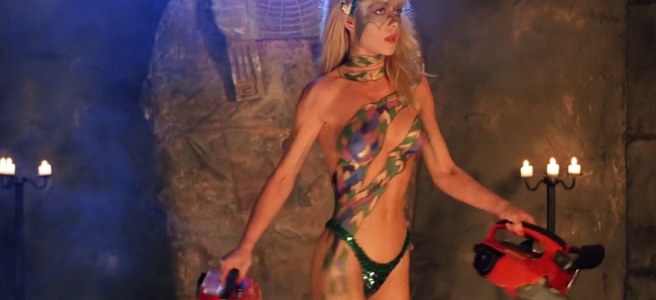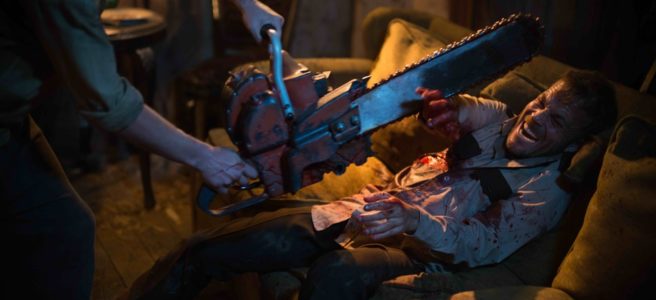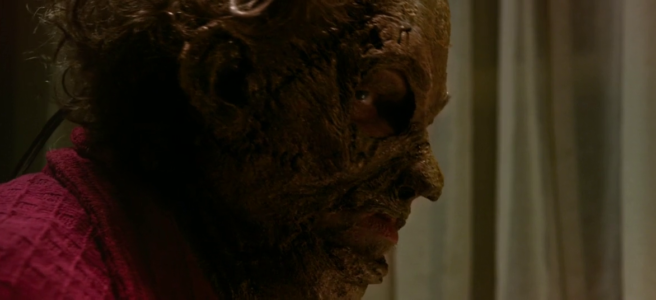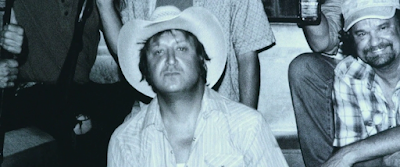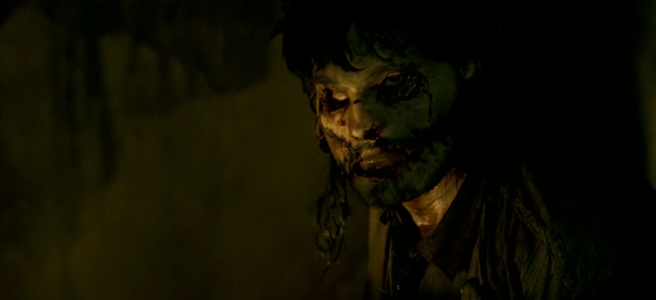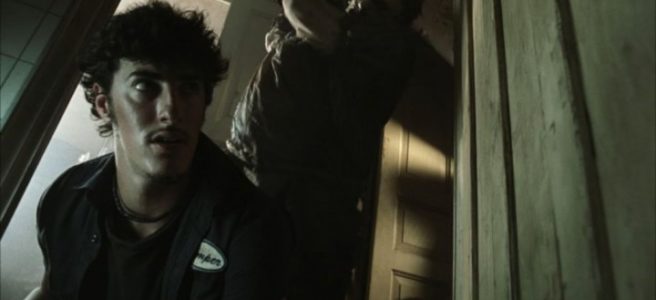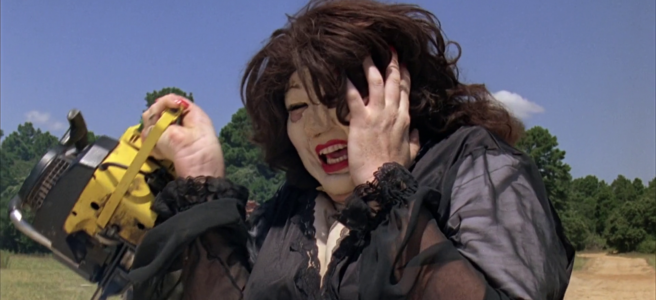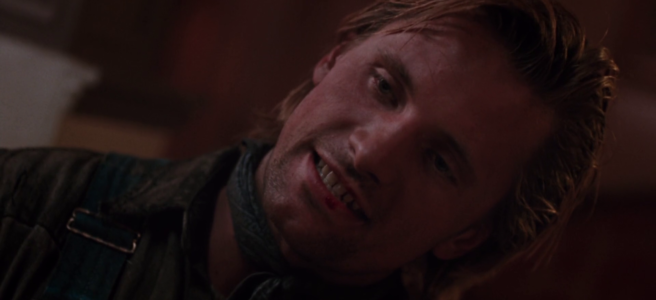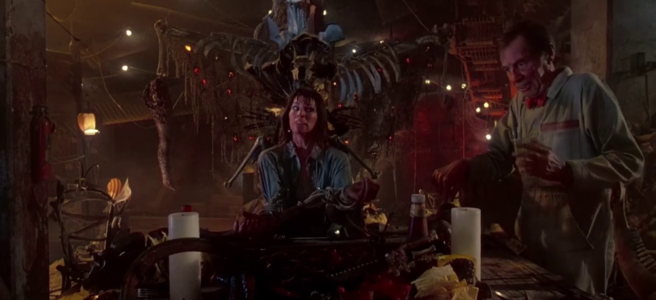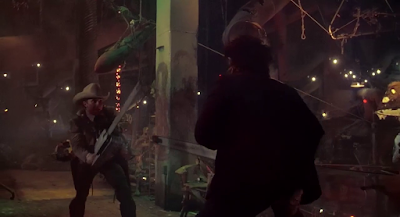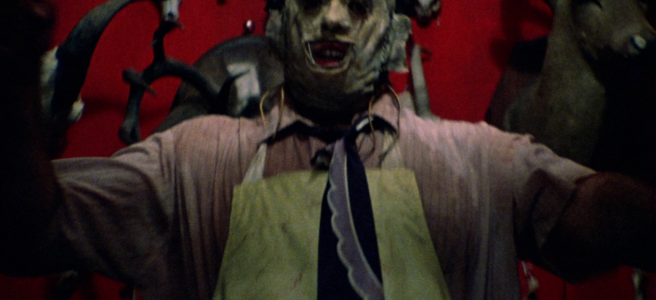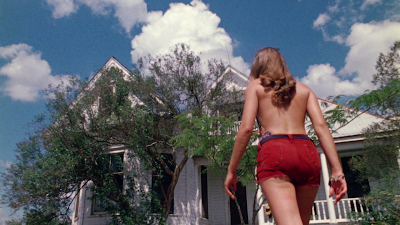Surprise! You didn’t think that I was totally chainsawed out, did you? While working through the Texas Chainsaw retrospective, I was reminded that Gunnar Hansen appeared in another chainsaw-based film – 1988’s Hollywood Chainsaw Hookers. I’ve been aware of this film for a long time, having frequented BadMovies.org as a high schooler. Naturally, the bonkers title and some hilarious plot points (including an ancient Egyptian chainsaw cult!) have always kept this film on my radar, so I figured what better time to watch it than now, especially considering that this is my 250th blog post? After all, this is probably a Texas Chainsaw parody, so might as well append it onto this retrospective series, right? Read on to find out…
PRODUCTION
(Pretty much all of the info I have on the production of this film comes from this featurette on the making of Hollywood Chainsaw Hookers, I definitely recommend checking it out if you have the time!)
Fred Olen Ray had been working as director on low-budget films for a number of years in Hollywood, kind of like a cheaper, sleazier, less-successful Roger Corman. By 1985 he had begun working on several films per year, shooting as quickly and cheaply as possible. By the late 80s, Fred had struck a production deal with an adult video company called LA Video and their subsidiary, mainstream distribution company, Camp Motion Pictures. LA Video expressed interest in distributing a new film for Fred and it was here that he pitched his idea for Chainsaw Hookers. LA Video added “Hollywood” to the title to make it sound more like Texas Chainsaw Massacre and Fred managed to rope Gunnar Hansen into the project. This was, of course, at the time when both Cannon Films and New Line Cinema weren’t interesting in working with Gunnar Hansen since they didn’t think he was a big enough star, so it just goes to show how much wiser Fred Olen Ray was than either company. With Hansen on board and $25,000 in hand from LA Video in exchange for the home video rights, Fred went about making his film, rewriting a script by T.L. Lankford.
In addition to snagging Gunnar Hansen to play the main villain, The Master, Fred Olen Ray managed to get Linnea Quigley to play the female lead. Qugiley is best known for being naked in a number of famous horror roles throughout the 80s, and by this point had already been in Silent Night, Deadly Night and Return of the Living Dead, so Hollywood Chainsaw Hookers was more-or-less the perfect role for her. John Henry Richardson was also cast as the male lead, Detective Jack Chandler.
Naturally, this being a Fred Olen Ray film, he made it while working on other projects. While doing pick-ups on a low-budget movie called Moon in Scorpio, Fred agreed to take a lower pay cut in exchange for the use of Trans World Entertainment’s studio space and film equipment during downtime, which he would use to film Hollywood Chainsaw Hookers. As per the agreement, he had the equipment from Friday to Sunday, filmed the pick-ups for Moon in Scorpio Monday to Thursday and then finished Hollywood Chainsaw Hookers the next Friday to Sunday. All in all, he took about 5 1/2 days to shoot the film on a measly budget in the neighbourhood of $55,000. Naturally, the filming conditions were extremely sketchy – it was shot with no permits, on leftover sets from other films, with real chainsaws and even with real hookers on occasion! Even the film stock was as cheap as possible, using short ends which were left over from other films. The audio was all shot on set as well, so considering that there are chainsaws revving loudly on a number of occasions, you can’t tell what the characters are saying at all sometimes because there was no budget for redubbing dialogue. The conditions were also potentially dangerous for the cast, particularly since they were using real chainsaws – in one notable instance, Linnea Quigley (who had already spent seven hours in makeup) was locked inside of a coffin with two running chainsaws so that she could preform the film’s iconic virgin dance of the double chainsaws. Naturally, this meant that the coffin was quickly filled with chainsaw fumes and Quigley can be visibly seen stumbling out of the coffin because she could barely breathe.
Hollywood Chainsaw Hookers ended up being one of Fred Olen Ray’s more successful films. That said, I want to just look at his career a little bit. He’s been making mockbusters, sexploitation films and, most recently, freaking Hallmark Christmas movies in order to get by (I’m pretty sure I’ve even seen at lest one of those Christmas movies too, holy shit). He’s like The Asylum before that studio cornered the mockbuster market. Most obviously, in 1994 we’ve got Dinosaur Island (riffing on Jurassic Park), in 1998, Mom Can I Keep Her? (Mighty Joe Young) and in 2011, Bikini Time Machine (Hot Tub Time Machine). Oh, and he’s been releasing sleazy, borderline-softcore porno films throughout his whole career, although they seem to have picked up and become more pornographic since the 2000s. Just trolling through his directing credits, we’ve got such fantastic titles as Bikini Airways, Attack of the 60 Foot Centerfold, Thirteen Erotic Ghosts (which must have the best IMDb description ever), Genie in a String Bikini, Super Ninja Bikini Babes (which sounds like an alternate title for Dead or Alive) and Tarzeena: Jiggle in the Jungle. Lately, he’s been slumming it with shitty Christmas movies, having released 10 since 2007 (and 9 of those have been since 2012, bloody hell), and with cheap crime films, which should probably give you an idea of the cultural zeitgeist when these are the only profitable genres left.
PLOT SYNOPSIS
The film opens with Detective Jack Chandler recounting one of his strangest cases, via voiceover in true hardboiled noir style. We follow a hooker named Mercedes as she picks up a man and then kills him with a chainsaw later in her apartment. Apparently there have been a number of chainsaw hooker murders going down in Los Angeles lately, and Jack Chandler heads to the police station to check in on a chainsaw murder suspect who might be related to a missing girl case he’s taken on. The suspect is not the missing girl, Samantha, but Jack steals a piece of evidence with a phone number on it in order to get closer to the source of the chainsaw murders. The phone number leads Jack back to Mercedes and he arranges to meet her at a local club. When he gets there, he finds Samantha dancing as a stripper at the club, but is drugged by Mercedes before he can notify the authorities.
When Jack awakens, he is tied to a bed and surrounded by killer hookers, including Mercedes and Samantha. The Master comes into the room and informs Jack that he is the leader of an ancient Egyptian chainsaw cult and that he is going to sacrifice Jack to their god. The hookers then try to kill Jack, but their chainsaw has run out of gas. They order Samantha to guard Jack while they go to get gas from the corner store, but Samantha frees him. She reveals that she’s infiltrating the chainsaw cult because they killed her friend and she wants to get revenge on them. The pair escape back to Jack’s apartment, where Samantha suddenly falls in love him and the pair have sex.
That night, they try to sneak into the cult’s temple in order to stop their plans, but it’s a trap and they are captured. Samantha’s given a mind-control drug in order to be used in the ceremony, while Jack is tied up and prepared for sacrifice. After performing a ritual dance, Jack is brought to Samantha by The Master in order to be killed, but Samantha instead kills The Master and then gets into a chainsaw duel with Mercedes. Mercedes is killed by Samantha and the police arrive and round up the rest of the cult. Jack and Samantha kiss and Samantha is hired as Jack’s new secretary.
REVIEW
Okay, so other than featuring Gunnar Hansen in a chainsaw killer movie, there’s basically nothing that connects Hollywood Chainsaw Hookers to The Texas Chainsaw Massacre. It’s not even a slasher parody like I had originally expected. Instead, it’s a parody of pulp, noir detective films, very similar to The Naked Gun (which, coincidentally, came out the same year as this film). Naturally, this movie isn’t anywhere near as funny as The Naked Gun, but it is much funnier than I was expecting it would be… usually intentionally! John Henry Richardson’s Jack Chandler doesn’t have the same sort of comical ineptitude or deadpan delivery as Leslie Neilson’s Frank Drebin, instead Jack Chandler is played with more of a sarcastic, over-confident tone that often gets him into trouble. He makes for a great stereotypical detective lead, which just makes it funnier when he spouts some of the absolute best, cheesiest lines in the whole film. The delivery of lines like “If my head wasn’t hurtin’ so much, I’d have sworn I was in heaven – heaven for guys who liked big tits” was enough to have me laughing out loud throughout the film. John Henry Richardson’s acting is by far the best in the film and I definitely need to give special mention to the monologue that he turns into Jack’s best line in the whole film:
“I’d stumbled into the middle of an evil, insidious cult of chainsaw worshipping maniacs. I had to wonder if we’d let our religious freedom go too far in this country, or maybe our immigration laws were just too lax. I’ve never been much for politics, but I kept thinking about that pretty girl’s warm head on my lap, and then I wondered how many other pretty girls would never be able to put their heads on my lap because they’d been cut off by that refugee from the BTL club and his slice-happy sluts, I started to get mad.”
Holy shit, that is the funniest anti-immigration screed I’ve ever heard, I love it. Honestly, I was cringing when that monologue started, but by the middle I was in stitches I was laughing so hard.
There really are a lot of good jokes in this film and I just want to highlight a few of my favourites here. When Jack gets captured he keeps guessing The Master’s plan by throwing out the most ridiculous ideas he can think of (“What is this, some ancient chainsaw-wielding cult?” “Actually, that’s just what this is”) to the point where he just starts saying tropes and The Master ends up asking how Jack knows all of this. The idea of there being an ancient Egyptian cult with chainsaws is also lampshaded in a very tongue-in-cheek fashion which I appreciated. I also found it hilarious how the official police explanation for one of the chainsaw murders is that it was an accident and the victim “was just cleaning his chainsaw when it went off”. There’s also a chainsaw murder at the start of the film where a hooker kills some police officers during an interview and later it is explained that the policemen forgot to take the gas out of the chainsaw, paving over a pretty obvious plot hole in the funniest way possible. There are also some pretty good sight gags in the film, such as when Jack’s voice over during a scene is obviously at odds with what actually happens, just so that he can make himself look better. My favourite WTF sight gag though is when Jack enters a strip club and the camera focuses on the tough customers at the bar staring at him, which inexplicably ends with this pissed-off, twelve year old ginger kid (who, apparently, was Fred Olen Ray’s son). The film doesn’t even acknowledge it, which makes it even funnier.
Like I said, most of the jokes in this film land, although there are plenty of laughs to be had from the cheap film-making and bad acting. Most of the dialogue is on the level of a bad porno, especially during the chainsaw murder scenes. The early scene where Mercedes murders Bo Hansen has some of the funniest bad acting that I’ve ever had the pleasure of seeing. Hearing Bo, after realizing his sexy times are coming to an abrupt, gasoline-fueled end, whelps “Oh no! Oh no! GAHHHH!!!” in the funniest way possible. The murders themselves tend to be really funny too, as there’s obviously someone off-screen spraying the hookers with fake blood while someone else tosses a bucket of blood at them and someone else throws fake fingers (to top it off, someone tries to grab Mercedes’ boob with a fake severed hand, fantastic). It’s so obviously fake and amateur that it makes these scenes really funny to watch. The terrible, Value Village-quality Egyptian costumes at the end also could only work in a cheap parody movie like this.
That said, not all of the jokes land and there are some stinkers in here. Probably the most offensive joke is when Jack calls the homicide squad the “homo squad”, which came across to me like it was meant to be “funny because gay”, but just made me cringe a little. Thankfully, I didn’t notice any other homo- or transphobic jokes in the film, which is actually somewhat impressive for a film this old. The film also seems to think that it’s hilarious that a slang term for detective is “dick”. Sure, it was actually quite funny the first time the police chief complained about having “another private dick in my face”, but by the fourth or fifth “dick = detective = penis” joke, it was a bit much. Then there are a few jokes which are just stupid, like when Jack tries to get the bartender’s attention by… making shadow bunnies on the wall? Umm, okay, that feels like they were trying a little too hard for a laugh.
Of course, in addition to being a comedy, Hollywood Chainsaw Hookers is a straight-up exploitation film with tons of gratuitous nudity to satisfy its thirsty audience. The film has tons of nudity and porno-level dialogue, but I wouldn’t say it reaches the level of a softcore porn film, if only because there are no sex scenes. That said, the chainsaw killings are treated in the way that a sex scene normally would, where the killing is the… er… “big climax” that the narrative builds towards, and of course they are all shot with topless women getting coated in buckets of blood. Naturally, there is plenty of gratuitous nudity even outside of the chainsaw killings, to the point where I’d estimate that maybe half of the movie has some nudity in it… and hey, considering the type of movie this is, at least it’s delivering the goods. Funnily enough, Fred Olen Ray has stated that the film was intended to be a message about safe sex – after all, any person you pick up could turn out to be a chainsaw-wielding maniac if you’re not careful.
Unfortunately, the film loses steam towards the end after The Master appears and Jack meets Samantha. Part of the problem is that around the forty-minute mark, Jack starts turning into a misogynistic douche bag. For one thing, Samantha is introduced as a surprisingly strong woman, who infiltrated this cult in order to get revenge for her friend’s death. However, she is quickly knocked down a peg when Jack headbutts her to knock her out, and then when she wakes up she immediately forgives him and then… tries to have sex with him because she’s so impressed!?! What the hell? This is followed-up by Jack’s girlfriend walking in on them, but Jack doesn’t care when she breaks up with him because he’s found himself a younger, hotter woman now. At this point, all of Jack’s one-liners start becoming about objectifying Samantha. Oh, and if that all wasn’t bad enough, it’s definitely implied that Samantha is lying about her age and is possibly a minor. I get that this is parodying noir tropes, but it doesn’t have any sort of consequence for Jack, which really bothers me and just makes it come across like they’re just playing it straight. It certainly doesn’t sink the film, but it makes it harder for me to give a shit about the film’s hero.
However, the last fifteen minutes of the film are by far the worst. The film is barely over the hour mark and I feel like the last fifteen minutes suffer because they were padding for time to get the film a proper runtime. There’s a good eight minutes that bring the film’s pacing to a grinding halt. Picture this – we’re in the cult’s temple and watching a ceremony, wondering what is going to happen. Then, we’ve got several minutes watching a priest pour a can of oil out… and then pour another can of oil. Umm, okay, where is this going? Then a topless hooker comes out and starts fire breathing, again, for several minutes without leading to anything. Then we get the film’s virgin dance of the double chainsaws, which manages to be iconic, badly done and pointless at the same time. On the one hand, it’s Linnea Quigley dancing topless with a pair of chainsaws, so there’s an inherent level of sexiness and coolness to the scene which helps to carry it. Unfortunately, it’s also hard to ignore that the dance is not particularly sexy in itself – as I’ve mentioned, Linnea was high on gas fumes, exhausted from seven hours of makeup and wielding two real, heavy chainsaws and trying to do something to arouse the audience. Again, it works because of her inherent sexiness, but it’s extremely obvious that she’s not able to give 100%. Add in that the editing during this entire temple ritual sequence has tons of pointless cut-aways to random hookers (I swear that several of these shots are recycled during the scene as well), and it becomes obvious why the final fifteen minutes of this film are so tedious to sit through.
As for the performances in this film, they’re pretty bad on the whole. Like I said earlier, John Henry Richardson’s acting is by far the best, but nearly everyone else is pretty bad. Unfortunately, even Gunnar Hansen puts in a very bland performance as The Master, saying all of his lines in a very monotone voice. That’s just too bad, I was hoping we’d get some scenery-chewing from him. I’m also sad to say that Linnea Quigley’s acting is really poor in this film. Her line deliveries are all unconvincing and the choreography during her epic chainsaw duel with Mercedes is just pathetically awkward – like, imagine a grade-school film project sword fight and you’ll have an idea of how badly-choreographed this fight is. Thankfully, as Jack Chandler says, “The kid talked like a frosted flake, but she had the nicest set of knockers that I’d seen in a long time”.
Hollywood Chainsaw Hookers was shot for about $55,000 in five and a half days. That’s an insanely low budget and shooting time for any film. You can definitely tell that this film was done under both of those constraints, but dayum it looks really good in spite of that. I can’t exactly call this a good movie in terms of quality, but in terms of pure fun it’s a hoot, even if the last act brings it down somewhat.
4/10
